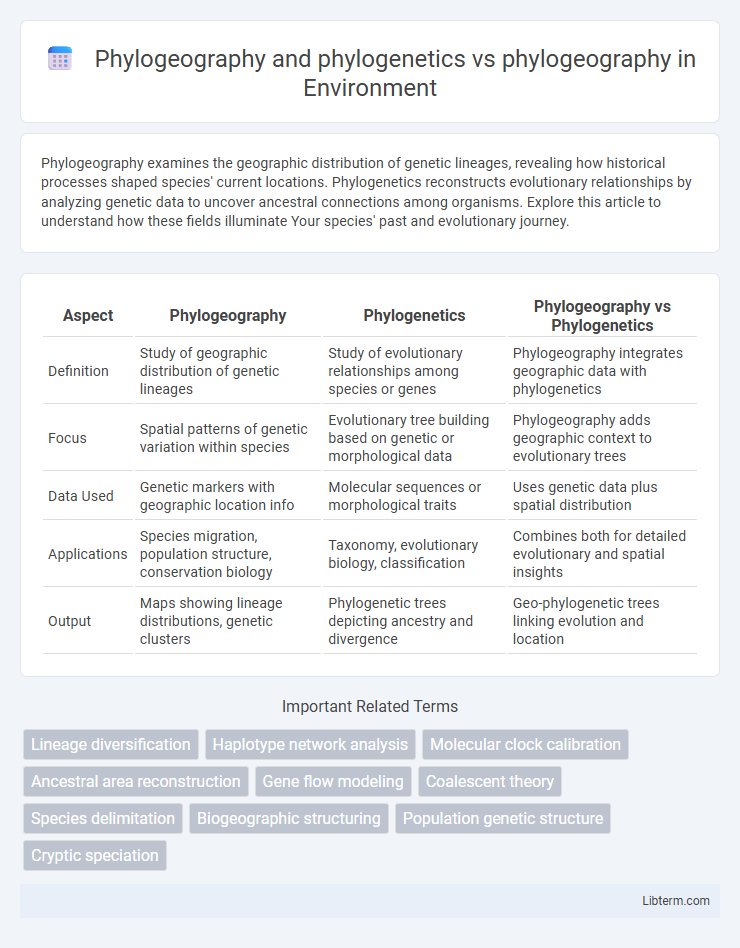Phylogeography examines the geographic distribution of genetic lineages, revealing how historical processes shaped species' current locations. Phylogenetics reconstructs evolutionary relationships by analyzing genetic data to uncover ancestral connections among organisms. Explore this article to understand how these fields illuminate Your species' past and evolutionary journey.
Table of Comparison
| Aspect | Phylogeography | Phylogenetics | Phylogeography vs Phylogenetics |
|---|---|---|---|
| Definition | Study of geographic distribution of genetic lineages | Study of evolutionary relationships among species or genes | Phylogeography integrates geographic data with phylogenetics |
| Focus | Spatial patterns of genetic variation within species | Evolutionary tree building based on genetic or morphological data | Phylogeography adds geographic context to evolutionary trees |
| Data Used | Genetic markers with geographic location info | Molecular sequences or morphological traits | Uses genetic data plus spatial distribution |
| Applications | Species migration, population structure, conservation biology | Taxonomy, evolutionary biology, classification | Combines both for detailed evolutionary and spatial insights |
| Output | Maps showing lineage distributions, genetic clusters | Phylogenetic trees depicting ancestry and divergence | Geo-phylogenetic trees linking evolution and location |
Introduction to Phylogeography
Phylogeography investigates the historical processes shaping the geographic distribution of genetic lineages, emphasizing the spatial arrangement of genetic variation within and among populations. In contrast, phylogenetics reconstructs evolutionary relationships based on genetic or morphological data without focusing primarily on geographic context. Introduction to phylogeography highlights its integrative approach, combining genetics, geography, and ecology to understand species dispersal, population structure, and historical biogeography.
Defining Phylogeography and Phylogenetics
Phylogeography investigates the historical processes shaping the geographic distributions of genetic lineages, integrating population genetics with biogeography. Phylogenetics reconstructs evolutionary relationships among species or genes using tree-like diagrams called phylogenies based on genetic or morphological data. While phylogeography emphasizes spatial patterns and demographic history within species, phylogenetics centers on branching evolutionary lineages across taxa.
Historical Background and Methodological Evolution
Phylogeography integrates phylogenetics and biogeography to study the historical processes shaping species' geographic distributions, originating from Avise et al.'s seminal work in the 1980s that combined molecular genetics with spatial data. Phylogenetics focuses primarily on reconstructing evolutionary trees based on genetic sequences to infer relationships without necessarily accounting for geographic context. Methodological evolution in phylogeography expanded with advances in molecular markers, coalescent theory, and spatial analysis tools, allowing more precise interpretations of lineage divergence and population structure across landscapes.
Comparative Overview: Phylogeography vs. Phylogeography with Phylogenetics
Phylogeography integrates geographic distribution and genetic lineage data to elucidate species' historical population structures, while phylogenetics focuses on reconstructing evolutionary relationships based on genetic sequences. Comparative analysis demonstrates that combining phylogeography with phylogenetics enhances resolution of migration patterns, genetic divergence, and ancestral lineage tracing by incorporating both spatial context and evolutionary history. This integrated approach leverages molecular markers, geographic information systems (GIS), and coalescent models to provide comprehensive insights into biodiversity and speciation processes.
Integrating Genetic Data: Approaches and Technologies
Integrating genetic data in phylogeography and phylogenetics involves combining molecular markers such as mitochondrial DNA, nuclear DNA, and genomic sequences to unravel evolutionary histories and biogeographic patterns. Advanced technologies like next-generation sequencing (NGS) enable high-resolution population structure analysis and species delimitation, facilitating a more comprehensive understanding of lineage diversification and historical migrations. Employing bioinformatics tools for multilocus sequence analysis and spatial modeling enhances the interpretation of genetic diversity within ecological and evolutionary contexts in phylogeographic studies.
Case Studies Illustrating Phylogeography Alone
Case studies illustrating phylogeography alone often emphasize the geographic distribution of genetic lineages to infer historical population movements, such as glacial refugia in European brown bears revealing postglacial recolonization patterns. These studies utilize mitochondrial DNA sequences and landscape genetics to connect genetic diversity with environmental variables, highlighting how physical barriers like mountains or rivers shaped species divergence. Unlike integrative approaches combining phylogenetics and phylogeography, these focused analyses pinpoint spatial genetic structures without reconstructing detailed evolutionary trees.
Advantages of Combining Phylogeography and Phylogenetics
Combining phylogeography and phylogenetics enhances the understanding of species' evolutionary histories by integrating geographical distribution with genetic lineage relationships. This synergy allows for more precise reconstruction of migration patterns, demographic events, and diversification processes through time using molecular data. The combined approach improves resolution in biogeographic inference, facilitating insights into how geological and climatic changes influence genetic structure across populations.
Limitations and Challenges in Both Approaches
Phylogeography integrates genetic data with geographic distribution to trace evolutionary lineages, but faces challenges like incomplete lineage sorting and spatial sampling bias. Phylogenetics primarily reconstructs evolutionary relationships using genetic sequences yet struggles with horizontal gene transfer and limited resolution in rapid radiations. Both approaches are limited by insufficient fossil records and computational constraints in handling large genomic datasets.
Recent Advances and Future Directions
Recent advances in phylogeography integrate high-throughput sequencing and spatial modeling, enhancing resolution in tracing species' historical distributions and gene flow. Phylogenetics, focusing on evolutionary relationships through molecular data, increasingly complements phylogeographic studies by providing robust, time-calibrated phylogenies that clarify lineage divergence and biogeographic patterns. Future directions emphasize combining environmental DNA (eDNA) with phylogeographic frameworks and developing machine learning algorithms to predict evolutionary responses to climate change and habitat fragmentation.
Conclusion: Synthesizing Insights from Both Fields
Phylogeography integrates genetic data and geographic distribution to trace population histories, while phylogenetics reconstructs evolutionary relationships among species using genetic sequences. Synthesizing insights from both fields enhances our understanding of species evolution by combining lineage divergence timing with spatial patterns of genetic variation. This holistic approach informs conservation strategies and clarifies biogeographic processes driving biodiversity.
Phylogeography and phylogenetics Infographic

 libterm.com
libterm.com